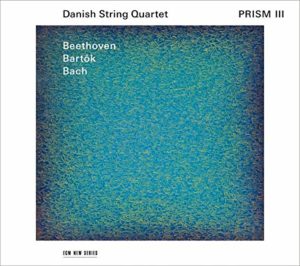It is fitting that the Danish String Quartet programs Beethoven’s C-sharp minor quartet Op. 131 alongside Bartók’s Quartet No. 1, for their commonalities are revealing. Each work’s movements play continuously without interruption. And just as Beethoven begins his quartet with a brooding, intensely building fugue, Bartók accurately described his work’s long contrapuntal opening movement as a funeral dirge. In this context, the five-voice Fugue from Bach’s Well-Tempered Clavier makes for an appropriate closing selection.
The musicians shape Beethoven’s opening fugue with careful attention to dynamics and specifically contoured vibrato. Their quasi-reedy timbre in the second movement underscores the music’s disarming lilt, which makes the third movement’s transitional cadenza sound all the more abrupt and surprising. The fourth-movement variations’ light, silvery textures prevent the deliberate tempos from sounding overly heavy or monumental. On the other hand, the appreciably brisk Presto seems a bit cool, especially where the two-note phrases pass from instrument to instrument. But the ferocity with which the ensemble attacks the finale’s dotted rhythms still allows for cogent textural balancing and motivic interplay to transpire.
Technical refinement similarly operates on the highest level throughout the Bartók, particularly in soft high-lying material and in unison passages. When the third movement’ s Allegro vivace kicks in, the repeated notes pulsate much less aggressively than in most performances, while in slow and rhetorical passages the musicians prioritize internal balances and control over the kind of febrile, heart-on-sleeve phrasing you hear in the Emerson, Vegh, and both Takacs Quartet recordings.
The Bach fugue’s long and sustained keyboard lines readily lend themselves to the string players’ subtle dynamic inflections and vocally informed legato phrasing. While these performances will not displace the Vegh and Takacs Beethoven and Bartók recordings from my reference perch, one cannot question the Danish String Quartet’s finesse, scrupulous attention to detail, and musical integrity.
































